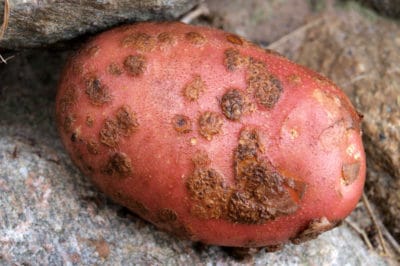About Potato Scab
Potato scab is the result of a bacterial infection caused by Streptomyces scabies or S. acidiscabies. It typically remains in the soil and can infect subsequent crops even if you practice crop rotation. The severity of the infection can vary from season to season and even from one field to another. Cropping history, soil texture, soil moisture and planting susceptible varieties can all affect the severity of the infection.
Recognizing Scab
Scab lesions can look quite different even when caused by the same organism. You will not find them until you harvest the tubers. The three main types are russet, erumpent and pitted:
- Russet scab causes thin, brown, round spots that have a netted appearance.
- Erumpent scab causes raised, irregular brown lesions that look like brown moss.
- Pitted scab results in craters with a raised edge and a dark brown to black center.
Potato Scab vs. Acid Scab
Although both of these are bacterial infections caused by related organisms, soil pH plays a role. A soil pH of 5.2 or lower helps suppress or control common scab. Acid scab seems to be limited to several states in the Northeast and can occur in soils with a pH as low as 4.0. Acid scab can also occur in soils where the pH is higher. The lesions are similar in both.
Scab and Potato Varieties
S. scabies occurs in nearly all soils. Planting scab-susceptible varieties tends to make the problem worse, as the plants provide a host that makes the pathogen increase rapidly. Rotating potatoes with grains and other non-host plants can reduce the population. However, in the right environmental conditions, scab can still occur in a field even if you haven’t planted potatoes for several years.
Lowering pH
If your problem is common scab, keeping the soil pH below 5.2 can be helpful. Compost, aged manure and organic soil amendments such as alfalfa meal increase humus and lower pH. Pine needles are acidic and can also help if applied to the soil or composted. Elemental sulfur can help if it is well dispersed by thorough mixing. It is only effective when used in summer and will take several weeks to months to break down.
Prevention Strategies
Use scab-resistant varieties such as Chieftain, Norland, Viking, Gold Rush, and Russet Burbank. Rotate your potato growing areas with small grains, corn or alfalfa. Don’t plant radishes, beets or carrots, which are alternate hosts. Don’t let potatoes become stressed for water, especially once the plant starts to form tubers (after flowering).
